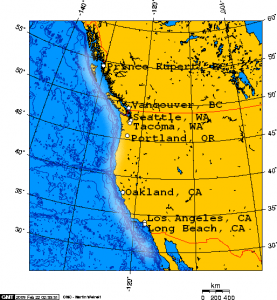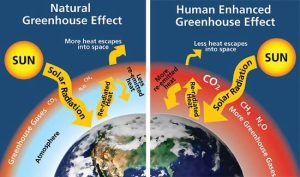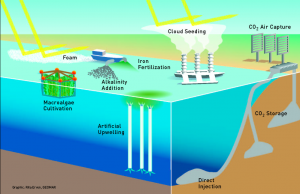
Modified image of a North American West Coast Map with the Pacific White Line highlighted. Source: Wikimedia Commons
For the longest time, scientists around the world never understood the phenomenon behind the Pacific White Line – a line off the coast of North America so large that it can be seen from space. Last year that all changed when marine researchers from the Oregon State University published their findings from their investigations on the Northern California coast. Using acoustic technology, they’re the first to discover that what was previously thought to be a random feature of the Pacific actually acts as a boundary for fish in the ocean. If not acted upon sooner, this boundary driven by climate change could threaten not only the lives of fish but ours, too.
How does this affect us?
The Pacific White Line is one of many tidelines, which form due to strong winds and colliding bodies of water. These regions are nutrient-rich, attracting and accumulating marine life. Although tidelines altogether only make up 1% of the world’s oceans, this 1% contributes to 20% of the global fishing in the world, making it “one of the most productive areas for fisheries” according to Dr. Mei Sato who led the research team.
The problem, however, is that as global warming worsens, this pushes the line further off the coast where fish such as sea bass, tuna, and mackerel can’t reach their prey residing at the line. If fish don’t have food, they can’t survive, and this puts a dent in the food web, the fishing industry, and our food resources. In the following podcast, Dr. Sato further discusses the tidelines, which she refers to as ‘upwelling fronts’, and how they are impacted by climate change.
What can we do moving forward?
With this new discovery comes a scare. Previously, it was thought that the Pacific White Line equally attracted smaller marine life, such as plankton, and larger organisms, such as fish. Clearly, the researchers discovered that wasn’t the case; fish are farther from their prey than they’d like to be. Using acoustic equipment, Dr. Sato and her team were able to determine how marine life was distributed at and around the line, which she explains in the following video:
Video Credit: Breyanne Bautista, Nicole Bostan & Ryan Chang; Source: Youtube
While the research demonstrates that fish are unable to reach their prey at the Pacific White Line, Dr. Sato believes that some other mechanism must be at work allowing them access to food since it’s not like fish populations are instantly depleting. “The mechanism is important to understand to be able to predict the future,” she says. She hypothesizes that plankton may be able to migrate to and from the line at different times of the day but added that higher resolution equipment is needed to explore this.
(By Breyanne Bautista, Nicole Bostan & Ryan Chang)



